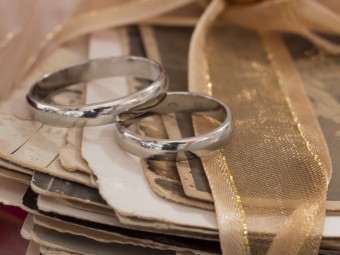How Do They Make White Gold White Given That It’s an Element?
 The purest form of gold is, of course, golden and is referred to as 24 karat gold. Pure gold is much too soft for use in jewelry and can even be dented by simply pressing your fingernail hard against it. Needless to say, daily wear, particularly for things like rings and bracelets, would see such jewelry bent and deformed quite quickly. So the gold must be made more durable by mixing it with another kind of metal or metals, creating a gold alloy.
The purest form of gold is, of course, golden and is referred to as 24 karat gold. Pure gold is much too soft for use in jewelry and can even be dented by simply pressing your fingernail hard against it. Needless to say, daily wear, particularly for things like rings and bracelets, would see such jewelry bent and deformed quite quickly. So the gold must be made more durable by mixing it with another kind of metal or metals, creating a gold alloy.
As far as terminology goes, the 24 karats that make up pure gold translate to all twenty-four parts being gold. So an 18 karat gold ring is constructed of 18 parts pure gold and 6 parts something else, adding up to a total of 24 (75% gold, 25% other). The same formula can be applied to any karat of gold jewelry, such as a 14 karat gold pendant- made up of 14 parts gold and 10 parts other metals.
So what are these other metals? If the desired result for a particular piece of jewelry is still a golden color, common metals mixed with gold include copper and zinc.
With white gold, the jeweler typically uses metals like silver, palladium, manganese, and nickel, with nickel for a time being the main bleaching agent due to its cheapness. However, nickel has fallen out of favor in some jewelry circles because it more commonly causes allergic reactions.
All that said, while the resulting piece in these cases will be bleached to more of a silvery color, it doesn’t typically produce the vibrant silver hue commonly associated with white gold today. (Although, there are methods to achieve this that have been very recently developed.) But for the vast majority of white gold out there, the vibrant silver color is created by coating the white gold alloy with a thin layer of rhodium, a metal in the platinum family.
The choice of rhodium comes from its bright white color along with its extreme durability. Eventually, though, it will wear down, at which point it will reveal the yellow tint of the white gold beneath. Depending on the exact makeup of the white gold, this may be barely noticeable to extremely apparent. With unscrupulous jewelers, they may even simply use regular yellow gold alloys plated with rhodium in their “white gold” as a way to save a little money in production. The buyers would have no idea until the rhodium wore off, which takes a while.
Whatever the case, if you notice a yellow tint after a while, simply having the white gold cleaned then having a jeweler apply a new coating of rhodium returns the metal to its previous silvery shine, and usually is relatively inexpensive to have done. In some cases, jewelers even offer this service free if you originally purchased the item in question from them.
If you liked this article, you might also enjoy our new popular podcast, The BrainFood Show (iTunes, Spotify, Google Play Music, Feed), as well as:
- The Jewelers Speech That Cost Nearly a Billion Dollars
- How One Man’s Attempt to Create the Philosopher’s Stone Out of Human Urine Led to the First Element Discovered Since Ancient Times
- A Brief History of the Gold Standard in America
- When Aluminium Cost More than Gold
- How the California Gold Rush Started
Bonus Facts:
- While yellow gold and white gold tend to be the most common in jewelry, other colors can be made by adding different metals to the gold. For instance, pink and rose gold is made by adding a higher ratio of copper, with the amount of copper added determining the hue. Green gold can be created by adding silver, copper, and zinc alloys. Even a black color can be achieved by coating white gold with a black rhodium.
- Platinum jewelry contains a greater percentage of platinum to alloys than the ratio of traditional gold to alloys in white gold, often containing 90% to 95% platinum with the remaining percentage of material generally being iridium, ruthenium, or cobalt.
- The 5 C’s of White Gold vs. Platinum
- Difference in Yellow, White and Rose Gold – Tulsa Gold and Gems
- What’s the difference between white gold and platinum?
- Does white gold actually have the same value as yellow gold?
- What is Gold? Frequently Asked Questions About Gold Jewelry
- Platinum vs. White Gold
- Metal Misconceptions: What Is My Ring Made Out of?
- White Gold’ History Is Somewhat Obscured By A Longstanding Misapplication Of The Term
- Gold
- White gold vs. platinum
- Gold Purity, Color, Pricing, and Care
- The Difference Between White Gold and Platinum
| Share the Knowledge! |
|





EXCELLENT ARTICLE. TROVE OF INFO. TNX
Wonderfully informative
very well said.